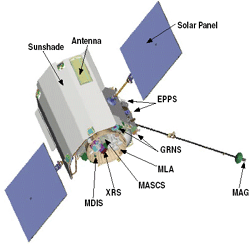The MESSENGER spacecraft lifted off on-time aboard a Boeing Delta II rocket from pad 17-B at Cape Canaveral Air Force Station, Fla., at 2:15:56.537 a.m. EDT. MESSENGER has successfully begun its mission to unravel the mysteries of planet Mercury
MESSENGER is a scientific investigation of the planet Mercury. Understanding Mercury, and the forces that have shaped it, is fundamental to understanding the terrestrial planets and their evolution. Just what is a terrestrial planet? It is a group of planets that are like Earth.
The MESSENGER spacecraft will orbit Mercury following three flybys of that planet. The orbital phase will use the flyby information as an initial guide to perform a focused scientific investigation of this mysterious world.
On a 4.9-billion mile (7.9-billion kilometer) journey that includes 15 loops around the Sun, the solar-powered MESSENGER will fly past Earth once, Venus twice and Mercury three times before easing into orbit around its target planet. The Earth flyby, a year after launch, and the Venus flybys, in October 2006 and June 2007, use the pull of the planets’ gravity to guide MESSENGER toward Mercury’s orbit. The Mercury flybys in January 2008, October 2008 and September 2009 fine-tune and slow MESSENGER’s track while allowing the spacecraft to gather data critical to planning the mission’s orbit phase.
Primary mission at Mercury:
Orbit for one Earth year (equivalent to four Mercury years, or two Mercury solar days), collecting data on the composition and structure of Mercury’s crust, its topography and geologic history, the nature of its thin atmosphere and active magnetosphere, and the makeup of its core and polar materials.
Source: NASA
























